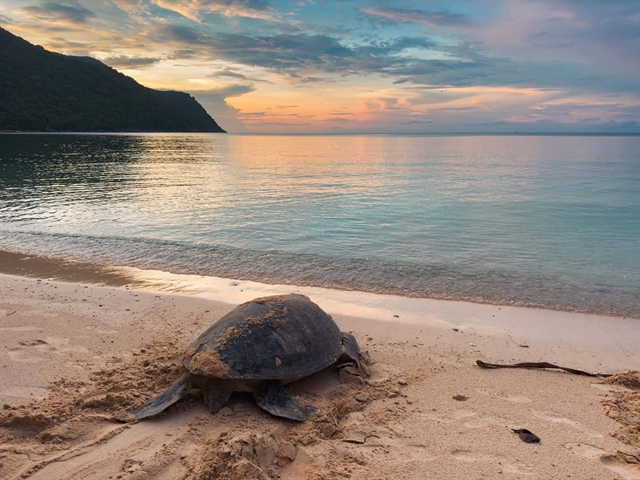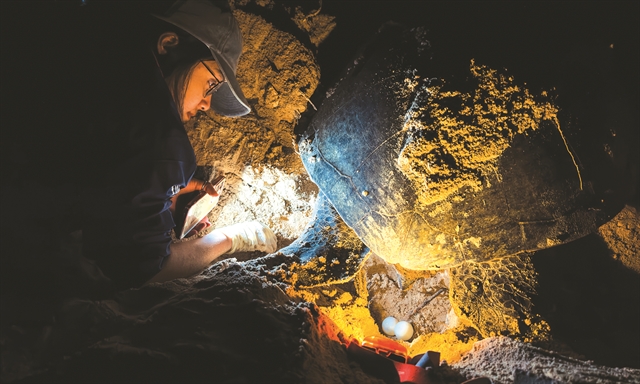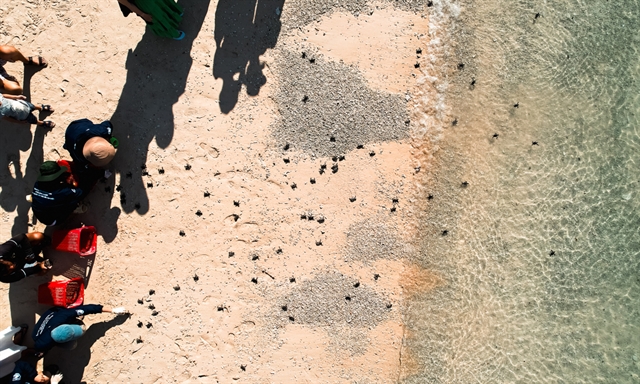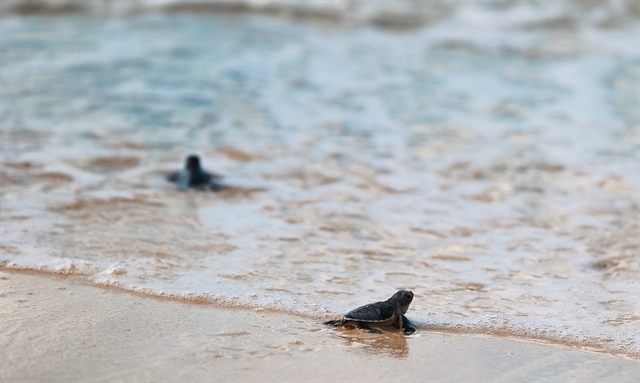Weather:
- Ha Noi 23oC
- Da Nang 21oC
- Ho Chi Minh 31oC

Văn Châu
An experience that tourists definitely cannot miss once in their lives is releasing turtles back to the sea in the Côn Đảo Archipelago, Bà Rịa Vũng Tàu Province.
Côn Đảo is a nature reserve, so there will not be many adventure sports activities going on in the water like in other famous islands and coastal cities such as Phan Thiết, Phú Quốc, Nha Trang or Đà Nẵng.
However, that is why visitors will have the opportunity to experience something completely different from other coastal cities in Việt Nam.
When coming to Côn Đảo, visitors will experience a pristine coastline, historical relics and turtles laying their eggs and releasing baby turtles into the sea.
Hòn Bảy Cạnh Island is the spot with the highest number of turtles laying eggs in Côn Đảo Archipelago. Here, you will have the opportunity to participate in a unique tour of releasing baby turtles back to the sea that have been cared for during the mother turtle's laying and incubation process.
To reach Côn Đảo and lay eggs, pregnant sea turtles have to travel thousands of kilometres from Malaysia. Here, mother turtles will receive professional and high-quality care. Each mother turtle usually lays more than 100 eggs. Afterwards, Côn Đảo National Park rangers collect the eggs for care and the mother turtle will quickly leave Côn Đảo and head back to Malaysia.
During the breeding season, from late April to October every year, Côn Đảo welcomes about 400 mother turtles to lay eggs.
Every year, more than 150,000 baby turtles are born here and released back into the ocean with a hatching rate of 87 per cent. Côn Đảo National Park has been recognised by the Việt Nam Book of Records as the place where the most baby turtles are released into the sea in the country.
Although mother turtles lay a lot of eggs and the hatching rate is very high, only one baby turtle out of 1,000 can reach adulthood. These low survival rates highlight the importance of sea turtle conservation efforts.

“Even though nearly a year has passed, I still cannot forget the experience of volunteering for a sea turtle conservation programme in Côn Đảo that lasted 12 days last July. This is a programme jointly organised by Côn Đảo National Park and the International Union for Conservation of Nature (IUCN),” Vinh Lê, from HCM City and a turtle conservation volunteer in Côn Đảo, said.
Côn Đảo National Park has 18 turtle-laying beaches, with a total area of up to tens of thousands of square metres. This sea area is where green turtles lay their eggs.
Mother turtles only come ashore to lay eggs around midnight, when the tide is high, usually from 11pm to 1am the next morning.
Beach guards will guide tourists and volunteers to follow the mother turtle's footprints to locate the egg nest.
The mother turtle uses her hind legs to dig a sand hole about 50-70 cm deep and then lays eggs in the hole. Each time, the mother turtle lays 70-200 eggs.

Mother turtles can lay eggs four times in four different nests, two weeks apart. Each turtle lays eggs for about 30 minutes or longer. After watching the turtles lay eggs, Vinh and the tourists bring the eggs to the incubation area in the reserve to protect them from animals or people who deliberately dig them up to sell.
Beach guards record information about where turtles lay their eggs and relocate eggs within a prescribed time. Accordingly, the eggs are moved to the care centre within six hours.
Trần Đình Đông, a beach guard in Côn Đảo, said: "In cases where the nests are located in remote places and cannot be moved to the centre within six hours, we will mark the nest and erase traces the mother turtle left and increase protection to prevent theft of turtle eggs for trade and relocate the eggs after 40 days. Sea turtles are very sensitive to sound and light, so these tasks must be done in the dark and specialised lighting must be used."
Although sea turtle protection is rigorous, the rangers, volunteers and participating tourists all feel very satisfied helping mother turtles and protecting baby turtles. All the hard work pays off when tourists release each baby turtle back into the sea.
'Wonderful experience'
Releasing baby sea turtles into the ocean is a unique activity only found in Côn Đảo. This activity attracts nature enthusiasts who want to experience the moment of watching baby turtles take their first steps to begin their journey into the vast ocean.
The temperature around the egg nest will determine the sex of the baby turtle. Normally, temperatures hotter than 29 degrees Celsius will increase the rate of female turtles.
Trần Trung Phú, a tourist from Tây Ninh Province, said that when visiting Côn Đảo with his family, he and his children did not miss the opportunity to experience witnessing mother turtles laying eggs and releasing baby sea turtles back to the sea. This experience is also an opportunity for his children to learn about nature and the importance of protecting marine life, thereby nurturing their love of nature.
“We are all beach lovers. So we have been to almost all the coastal cities and islands in Việt Nam as well as several other beaches around the world. However, Côn Đảo was truly a wonderful experience," he said.
"We saw everyone's efforts in helping mother turtles lay eggs and bring baby turtles back to the sea. Witnessing turtles lay eggs and participating in releasing baby sea turtles back into the ocean is a memorable experience of a lifetime. This is really helping us be more aware of the importance of protecting marine life and the environment.”

Lê Thị Ánh, a tourist from Hà Nội City, said that this activity was of great significance in preserving rare and endangered marine species listed in the World Red Book. It not only gave tourists a rich experience but also nurtured their love and responsibility for preserving nature, she said.
“I held a basket with 50 baby sea turtles in it, ready to be released into the sea. I witnessed their eager steps towards the sea. Those powerful and confident steps are truly an unforgettable experience in my life,” Ánh said.
“Even though I know the odds of these sea turtles living to adulthood are extremely low, by some miracle, I still hope all 50 of these baby turtles can reach adulthood in the coming years and will return to Côn Đảo to give birth to a new generation of baby turtles.”
"Exploration and experiential tours related to caring for and releasing baby turtles into the ocean are both memorable tourism activities for tourists and conservation activities. They bring exciting experiences while contributing to raising awareness and responsibility related to the conservation of sea turtles and Côn Đảo marine biodiversity," Ánh said.
The fee to participate in the turtle release experience combined with coral diving usually lasts half a day and costs VNĐ800,000 (US$34) per person.
However, turtle eggs and baby turtles provided to tourists by Côn Đảo National Park must be released back into the sea. Any act of storing turtle eggs or baby turtles violates Vietnamese law, with penalties of imprisonment and a fine of up to tens of thousands of US dollars.
The People's Court of Côn Đảo District recently prosecuted four individuals for storing five turtle eggs, resulting in a total sentence of two years of imprisonment and a fine of US$40,000.

Getting to Côn Đảo
March to the end of October is the ideal time for tourists to visit Côn Đảo. This time is considered suitable for tourists to visit the sea, dive to see coral and explore Côn Đảo National Park. This is also the time to witness sea turtles laying eggs.
Côn Đảo District is an archipelago off the coast of Bà Rịa Vũng Tàu Province. This 76sq.km archipelago includes 16 islands, the largest being Côn Sơn Island. Côn Đảo is 185km from Vũng Tàu City, 230km from HCM City and about 83km from the mouth of Hậu River in Cần Thơ City.
There are only two ways for tourists to get to Côn Đảo, speedboat and airplane.
Going by air is the most time-saving means of travelling to Côn Đảo. Tourists can depart from HCM City, Hà Nội City and Cần Thơ City with travel times of less than an hour.
If travel by speedboat, it will take visitors from three to six hours. Tourists can depart from Trần Đề Port in Sóc Trăng Province, HCM City and Vũng Tàu City.
Accommodation on Côn Đảo is very diverse. Visitors can choose affordable hotels with prices from only VNĐ300,000 to VNĐ700,000($12-28) per night, or visitors can also choose high-end accommodations with prices from VNĐ2,000,000-VNĐ30,000,000 ($80-1,200) per night. VNS


